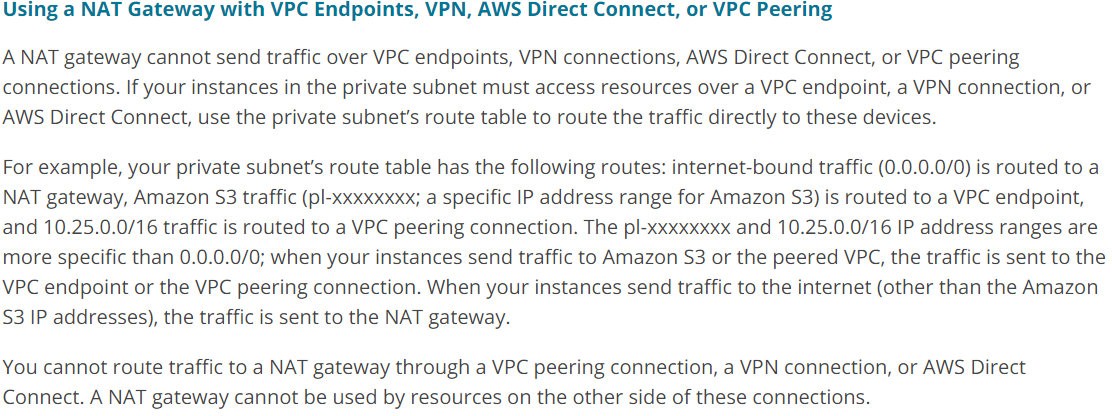VPC Peering and NAT Gateway Limitation
Question
Your organization had asked to be cost-efficient in designing AWS solutions.
You have created three VPCs(VPC A, VPC B, VPC C), peered VPC A to VPC B and VPC B to VPC C.
You have created a NAT gateway in VPC B and would like to use the same NAT Gateway for resources within VPC A and VPC C.
However, the resources within VPC A and VPC C cannot communicate to the internet through NAT Gateway, but resources in VPC B can communicate.
What could be the reason?
Answers
Explanations
Click on the arrows to vote for the correct answer
A. B. C. D.Answer: B.
In a VPC peering connection, using the NAT Gateway of another VPC becomes transitive routing and is not supported in AWS.
https://docs.aws.amazon.com/AmazonVPC/latest/UserGuide/vpc-nat-gateway.html#nat-For.
Option A, in VPC's route table, only NAT Gateway of the belonging VPC can be configured.
VPC A and VPC C cannot configure VPC B's NAT Gateway in their respective route tables.
This option is incorrect.
For Option B, as explained above, transitive routing is not supported.
This option is correct.
For Option C, even if two VPCs have peered and configured route tables with their entire IP range, as explained above, transitive routing is not supported.
This option is incorrect.
For Option D, the question says VPC B resources can communicate with the internet, for which NAT gateway should be on a public subnet.
So this option is not valid.

The reason why resources in VPC A and VPC C cannot communicate with the internet through the NAT Gateway in VPC B could be due to incorrect routing configuration in the VPC route tables.
When a VPC is created, a default route table is also created for the VPC. This default route table has a local route for all subnets in the VPC, but it does not have a route for internet traffic. Therefore, if resources in VPC A and VPC C need to communicate with the internet through the NAT Gateway in VPC B, the route tables in these VPCs need to be modified.
The correct answer is A. Route tables in VPC A and VPC C are not configured to have VPC B's NAT gateway. In order for resources in VPC A and VPC C to communicate with the internet through the NAT Gateway in VPC B, the route tables in VPC A and VPC C need to have a route that directs internet traffic to the NAT Gateway in VPC B.
To configure the route tables, the following steps should be taken:
In the AWS Management Console, navigate to the VPC Dashboard and select the VPC A.
Click on the "Route Tables" option on the left-hand side menu, and select the default route table for the VPC.
Click on the "Edit" button at the bottom of the route table, and add a new route to the NAT Gateway in VPC B. The destination should be "0.0.0.0/0" to route all internet traffic, and the target should be the NAT Gateway in VPC B.
Repeat steps 2 and 3 for VPC C's route table.
C is also a correct answer as VPC B's subnet which contains NAT gateway is not configured in VPC A and VPC C route tables. This means that the subnet in which the NAT Gateway is created in VPC B is not added to the route tables of VPC A and VPC C. Therefore, traffic from VPC A and VPC C is not being routed to the NAT Gateway in VPC B.
However, B is incorrect. Using another VPC's NAT Gateway is supported in AWS, and it is a common practice to use a single NAT Gateway for multiple VPCs to save costs.
D is also incorrect as the NAT Gateway needs to be created in a public subnet in VPC B. Otherwise, it will not be able to communicate with the internet. Therefore, the NAT Gateway in VPC B should be created in a public subnet, and the route tables in VPC A and VPC C should be configured to direct traffic to the NAT Gateway.